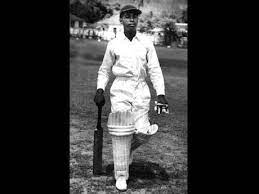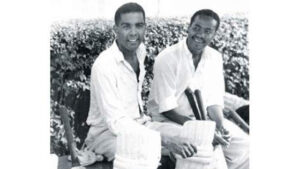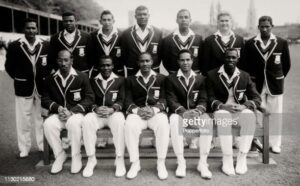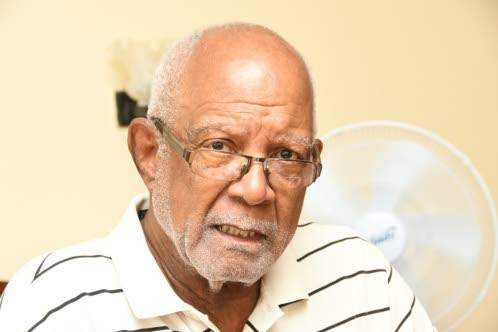By Ray Ford
As his very close friend and confidante
the following is from a January 2013
Tribute that was written by Ray
Ford on the former Jamaica and West Indies
batsman Easton ‘Bull’ McMorris who passed
away on February 1, 2022 at age 86. McMorris,
a right-hand opening batsman, played 13 Tests
for West Indies between 1958 and 1966. He
struck one Test century. A former Jamaica
captain, he scored 5,906 runs and averaged
42.18 in 95 first-class matches.
 Easton Dudley McMorris,was a cricketer and
Easton Dudley McMorris,was a cricketer and
government professional who excelled on
both fronts and at all levels. He was born on
April 4th, 1935, attended Kingston College
from 1948 until 1952 and represented the
school in Sunlight Cup and Minor Cup cricket.
His cricket career has outstanding
performances at every level. He cited his
highlights as first, playing for Nuttall in House
cricket in 1951, when he scored a century
while sharing in a 200-run partnership to
beat Hardie House; and in 1952 before his
seventeenth birthday, when he scored another
– his first in Senior Cup cricket, in a match for
Lucas Cricket Club against Kingston Cricket
Club. Then while playing for Jamaica, Easton,
between 1959 and 1962 scored a record five
centuries in five consecutive matches. The
last one – the 154, was made against India at
Melbourne Park, which incidentally, was in
the last international cricket fixture played at
that venue before the ground was acquired by
Kingston College as one of its campuses.
In 1962 McMorris also scored a Test
century – 125 for the West Indies against
the same India touring team at Sabina Park.
He captained Jamaica between 1968 and
1972, and lead teams overseas on several
occasions, including one to Bermuda in
1975 which included Michael Holding.
In 1969, Easton led the country to its
singular Shell Shield win. For these cricket
feats, and his unstinting government tenure,
Mr. McMorris was in 1972, bestowed the
Jamaica National Honor – The Order of
Distinction for Outstanding and Important
Service.
 As mentioned, Easton played cricket for
As mentioned, Easton played cricket for
Lucas Cricket Club – the now 117-year-old
institution – rising through the ranks from
Junior Cup to leading the Senior Cup team.
But Lucas can consider itself lucky to have
him because originally he had completed an
application to join the Kensington Cricket
Club, on the suggestion of the then KC
sports master Foggy Burrows, who was
also a member of Kensington. But Easton
was also a big fan of the great George
Headley who played for Lucas.
As a little boy living on Lacy Road, Easton
was taken by his elder brother to Lucas
one Sunday where he saw George Headley
playing pickup football. Later on, he was
captivated by the pictures of George
he had seen in the clubhouse. The lost
application offered Easton a chance to
reconsider the matter, and in so doing he
joined Lucas instead.
Easton’s election to join Lucas and
his idolization of George Headley say
something about his values. Because as the
Jamaican historian Lance Neita wrote of
George in his centenary: `He was an icon
in his time who was loved, not just for his
brilliance on the field, but because of his
dignity, quiet demeanour, sportsmanship,
discipline and application.’
McMorris first represented Jamaica in 1954
as a 19 year-old, and as a member of the
Jamaica Colts XI against England in 1953-
1954, and against Australia in 1955. He began
representing the senior team in 1956, and
in 1957, scored his first first-class hundred
against a touring Duke of Norfolk’s XI. Shortly
after, he played for a Jamaica XI against the
West Indies before the team left for the 1957
England tour. McMorris got a fifty which caught
the eye of the then West Indies captain John
Goddard, and was immediately earmarked as
a future West Indies opening batsman.
On leading the Jamaica team McMorris had a
simple theory: “All I did was to communicate
to my players what I was about and what
I thought the team could achieve.”
High praise for Easton’s leadership also came from
the classical Jamaica and West Indies Test
batsman Lawrence Rowe. “McMorris was a
great leader.” Rowe said recently. “He was a
disciplinarian who led by example and knew
how to manage men. He got the best out of
temperamental players. And as for me, I owe
a lot to Easton, because after a string of low
scores in away Shell Shield matches, people
were clamoring for me to be dropped.”
Also, in captaining Jamaica, at no time did any
McMorris-led team bring any disrepute to the
country. On that score, the former Jamaica
captain said this: “When you play for Jamaica,
especially abroad, you must represent the country well.” And so, let us hail McMorris as not only a great leader of men, but also as one who never stained our copybook.
In his career for Jamaica, Easton amassed 3,800 runs in fifty appearances, at an average of an even 50. And those of us who are not cricket aficionados must be reminded that to make those 3,800 runs, was no stroll in the park. Because in Shell Shield cricket alone, McMorris had to contend with the firebrand pace attack of Wes Hall and Charlie Griffith, the multifariousness of Gary Sobers all of Barbados, and the wizardry of Lance Gibbs of then British Guiana, just to name a few. It is no wonder therefore that in an interview appearing in the October 20th, 1981 edition of the Jamaica Daily News, the great West Indian batsman Vivian Richards, singled out Easton McMorris as his cricket idol as a kid.
“I saw it in the newspapers when I was abroad, and was humbled by that coming from Sir Viv,” McMorris noted. Viv’s mention is instructive in at least two ways. First, recall that McMorris had idolized Headley, and now, here comes Richards to idolize him. This meant that Easton had safely passed the baton. Secondly, this should remind us that in any endeavour, we should always strive to do our best, because, we never know who might be watching. It has also been said that when George Headley was a Jamaica coach and was asked by aspiring batsmen how to bat properly, the little master would say: `Just watch Easton McMorris bat.’

The West Indies on their 1957 tour of England had tried four opening pairs, and another in the first Test of Pakistan’s tour of the West Indies in 1957-58. None to their liking, the selectors gave Easton the call up. And so, on February 5th, 1958 the start of the second Pakistan Test at the Queen’s Park Oval in Port of Spain, Trinidad, Easton Dudley McMorris became the fourth Kingston College old boy after Francis James Cameron, John Kenneth `J.K.’ Holt, Jr., and O’Neil Gordon `Collie’ Smith, to play Test cricket for the West Indies.
His baptism into Test cricket was not kind. Because in his second innings when he was given out leg-before to the fast-medium bowler Fazal Mahmood, it was with a little help from the umpire. Of the dismissal, J.S. Barker wrote in the Trinidad Guardian: `Everybody in the ground at the Queen’s Park Oval heard the edge, except the presiding umpire.’ McMorris was promptly dropped and would not again see Test action until the first Test of the England series in Bridgetown, Barbados, in January 1960.
Easton’s return to Test cricket was described as `the ultimate nightmare’ – run out off a no-ball at the non-strikers end without having faced a ball. This would have broken any cricketer’s spirit, but not Easton’s. Injured for the second Test, he was brought back for the last three. However, in the fifth and final Test in Trinidad, McMorris was again snake-bitten: run out, this time from a clear umpiring error. It was Easton’s last chance to impress the selectors before the West Indies touring party was to be named for that historic 1960-61 tour to Australia. He thought he had done enough, but he was not included.
On missing out on the tour to Australia, Easton was (quote): `monumentally disappointed.’ But he might have remembered at the time, that Bishop Gibson had encouraged his KC cricketers to win or lose gracefully. And so, he accepted the disappointment with dignity and grace.
After his playing days, McMorris has remained close to the game, serving in several administrative capacities. He served as Chairman of the selection panel for the Jamaica Cricket Board, was a selector for the West Indies Cricket Board and served on the Development Committee of the Jamaica Cricket Association. Easton has been a cricket analyst and resource person for radio and television in Jamaica, and was made an Honorary Life Member of the Jamaica Cricket Association. McMorris who was Chairman of the Planning Committee for the George Headley Centenary in 2009 has also authored a book titled: Jamaica Cricket As I See It: A Selection from the Archives, 1850 – 1970.
Easton began his professional career in 1952 at the Colonial Secretary’s Office before joining the Ministry of Labour in Jamaica the following year from where he retired in 2004. He served in various ministerial divisions and in several capacities in between. These included the Recruitment of Overseas Workers Programme – 1953-1973 and in the United States with the U.S.A. Farm Workers Program – 1978-1989. He returned to Jamaica in 1990 where he reconnected with the Jamaica Civil Service to serve in the Canadian Farm Work Programme from which he retired in 1995. McMorris was Advisor to the Minister of Labour – 1994-1998; and a Senior Liaison Officer, U.S.A. Farm Workers Programme between 1994 and 2004.
Mr. McMorris is survived by his wife Avery and three children, all very successful in their careers. Mark the eldest is a professor in the Department of English at the George Washington University in Washington, D.C. Michael himself a Kingston College alumnus, is Chairman of the Victoria Mutual Building Society, and his daughter Anne is the Assistant General Manager, Group Operations at the National Commercial Bank.
Well played Easton!
